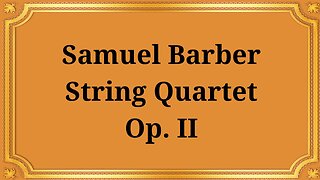Premium Only Content

Bach Flute Sonata BWV1032 & BWV1033
Johann Sebastian Bach's music continues to inspire and captivate audiences centuries after its creation. His flute sonatas are particularly noteworthy for their technical and musical complexity
Bach composed his six flute sonatas between 1720 and 1741. These works were written during his time in Leipzig, where he was the director of music at St. Thomas Church. The sonatas were likely composed for the Count of Schaumburg-Lippe, who was an accomplished flutist. It is believed that Bach composed these works to showcase the Count's talents and to demonstrate the capabilities of the newly developed transverse flute.
Bach's flute sonatas typically consist of three or four movements, with the first movement being in the fast-paced sonata form. The second movement is usually a slow and expressive aria or adagio, while the third movement is often a lively minuet or gigue. The fourth movement, when present, is usually a fast and virtuosic finale.
BWV1032
The Flute Sonata in A major, BWV1032, is one of Bach's most beloved works. This sonata consists of four movements: a fast-paced sonata form, a slow and expressive adagio, a lively and charming allegro, and a virtuosic and demanding presto. The sonata is notable for its intricate ornamentation, playful rhythms, and sophisticated harmonies, which showcase Bach's exceptional skill as a composer.
BWV1033
The Flute Sonata in C major, BWV1033, is another one of Bach's famous flute sonatas. This sonata consists of four movements: a fast-paced sonata form, a slow and expressive siciliano, a playful and upbeat allegro, and a virtuosic bourrée anglaise. The sonata is characterized by its expressive melodies, complex harmonies, and lively rhythms.
Bach's flute sonatas are considered some of the most important works in the flute repertoire. They are admired for their technical challenges, expressive melodies, and intricate harmonies. These works are also significant because they represent a pivotal moment in the development of the transverse flute, which was a relatively new instrument at the time.
In conclusion, Bach's Flute Sonata BWV1032 and BWV1033 are two of his most celebrated works. These sonatas are admired for their technical complexity, expressive melodies, and sophisticated harmonies. They are also significant because they represent a pivotal moment in the development of the transverse flute. As a result, they continue to be an essential part of the flute repertoire and are beloved by musicians and audiences alike.
Flute Sonata in A major, BWV 1032 00:00
Flute Sonata in C major, BWV 1033 14:37
-
 16:45
16:45
Classical music_Music Inspiration
20 days agoSamuel Barber String Quartet, Op. II
552 -
 25:38
25:38
The Rubin Report
2 hours agoRemembering Charlie Kirk & 9/11
44.7K8 -
 1:00:32
1:00:32
VINCE
3 hours agoRest In Peace Charlie Kirk | Episode 123 - 09/11/25
249K218 -
 LIVE
LIVE
LFA TV
6 hours agoLFA TV ALL DAY STREAM - THURSDAY 9/11/25
5,747 watching -
 LIVE
LIVE
Bannons War Room
6 months agoWarRoom Live
11,282 watching -
 DVR
DVR
The Shannon Joy Show
1 hour agoA message of encouragement and a call for faith and unity after the tragic killing of Charlie Kirk
8.72K6 -
 LIVE
LIVE
The Big Mig™
2 hours agoIn Honor Of Charlie Kirk, Rest In Peace 🙏🏻
2,731 watching -
 1:36:35
1:36:35
The White House
3 hours agoPresident Trump and the First Lady Attend a September 11th Observance Event
87.3K30 -
 1:38:49
1:38:49
Dear America
3 hours agoWe Are ALL Charlie Now! This Isn’t The End. We Will FIGHT FIGHT FIGHT
170K179 -

Badlands Media
10 hours agoBadlands Daily: September 11, 2025
53.5K8